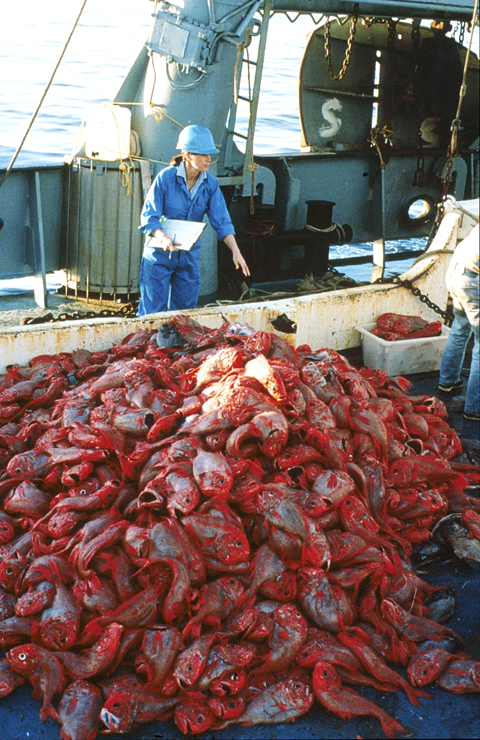Two years after a study warned that overfishing could cause a collapse in the world’s seafood stocks by 2048, an update says the tide is turning, at least in some areas.
“This paper shows that our oceans are not a lost cause,” said Boris Worm of Dalhousie University in Halifax, Nova Scotia, lead author of both reports. “I’m somewhat more hopeful ... than what we were seeing two years ago.”
It is personal as well as scientific.

PHOTO: REUTERS
“I have actually given thought to whether I will be hosting a seafood party then,” Worm said, meaning 2048.
Ray Hilborn of the University of Washington challenged Worm’s original report, leading the two — plus 19 other researchers — to launch the study that led to the new findings. They were published in Friday’s edition of the journal Science.
The news isn’t all good.
Of 10 areas of the world that were studied, significant overfishing continues in three, but steps have been taken to curb excesses in five others, Hilborn and Worm report. The other two were not a problem in either study.
Hilborn noted that 63 percent of fish stocks remain below desired levels. It takes time to rebuild after steps are taken to reduce the catch.
Rebecca Goldburg, director of Marine Science at the Pew Environment Group, said that “two scientists who once held opposing views about the state of ocean fisheries now agree about the significance of global fisheries declines and the solutions needed to reverse these trends. If fishery managers worldwide heed these important scientific findings, then we have an extraordinary opportunity to restore ocean fisheries.”
Michael Fogarty of the US National Oceanic and Atmospheric Administration noted a dramatic recovery of haddock on Georges Bank, off New England, as well as improvements in redfish, scallop and other fish. But still others, such as cod and flounder, remain vulnerable, he said at a briefing.
“We feel confident that the tide of overexploitation can be reversed on a global basis,” Fogarty said, citing such steps as exclusion areas, changes in fishing gear, assignments of rights to harvest and incentives for fishers to take a long-term view.
Two areas, Alaska and New Zealand, have led the world in terms of management success by not waiting until drastic measures are needed to conserve, the report said. These areas were not a problem in either study.
Regions where excess exploitation has halted are Iceland, southern Australia, the Northeast US, the Newfoundland-Labrador area and the California Current, which flows south along the US West Coast.
Still being overfished, the report said, are the North and Baltic seas and the Bay of Biscay region.
A newly developing problem is the movement of major fishing efforts to the developing world, with foreign fleets operating off east and west Africa.
These fleets compete with local fishers and almost all the fish they catch is taken to industrialized countries.
“The prognosis for Africa is not nearly as good as it is for wealthier areas,” said Tim McClanahan of the Wildlife Conservation Society in Mombasa, Kenya.
“Prior to this study, evaluations of the status of world fish stocks and communities were based on catch records for lack of a better alternative.
Results were controversial because catch trends may not give an accurate picture of the trends in fish abundance,” Ana Parma of Centro Nacional Patagonico in Argentina said in a statement.
“This is the first exhaustive attempt to assemble the best-available data on the status of marine fisheries and trends in exploitation rates,” she said.

RESILIENCE: Deepening bilateral cooperation would extend the peace sustained over the 45 years since the Taiwan Relations Act, Greene said Taiwan-US relations are built on deep economic ties and shared values, American Institute in Taiwan (AIT) Director Raymond Greene said yesterday, adding that strengthening supply chain security in critical industries, enhancing societal resilience through cooperation and deepening partnerships are key to ensuring peace and stability for Taiwan in the years ahead. Greene made the remarks at the National Security Youth Forum, organized by National Taiwan University’s National Security and Strategy Studies Institution in Taipei. In his address in Mandarin Chinese, Greene said the Taiwan-US relationship is built on deep economic ties and shared interests, and grows stronger through the enduring friendship between

GAINING STEAM: The scheme initially failed to gather much attention, with only 188 cards issued in its first year, but gained popularity amid the COVID-19 pandemic Applications for the Employment Gold Card have increased in the past few years, with the card having been issued to a total of 13,191 people from 101 countries since its introduction in 2018, the National Development Council (NDC) said yesterday. Those who have received the card have included celebrities, such as former NBA star Dwight Howard and Australian-South Korean cheerleader Dahye Lee, the NDC said. The four-in-one Employment Gold Card combines a work permit, resident visa, Alien Resident Certificate (ARC) and re-entry permit. It was first introduced in February 2018 through the Act Governing Recruitment and Employment of Foreign Professionals (外國專業人才延攬及雇用法),

EUROPEAN TARGETS: The planned Munich center would support TSMC’s European customers to design high-performance, energy-efficient chips, an executive said Taiwan Semiconductor Manufacturing Co (TSMC, 台積電), the world’s largest contract chipmaker, yesterday said that it plans to launch a new research-and-development (R&D) center in Munich, Germany, next quarter to assist customers with chip design. TSMC Europe president Paul de Bot made the announcement during a technology symposium in Amsterdam on Tuesday, the chipmaker said. The new Munich center would be the firm’s first chip designing center in Europe, it said. The chipmaker has set up a major R&D center at its base of operations in Hsinchu and plans to create a new one in the US to provide services for major US customers,

The Ministry of Transportation and Communications yesterday said that it would redesign the written portion of the driver’s license exam to make it more rigorous. “We hope that the exam can assess drivers’ understanding of traffic rules, particularly those who take the driver’s license test for the first time. In the past, drivers only needed to cram a book of test questions to pass the written exam,” Minister of Transportation and Communications Chen Shih-kai (陳世凱) told a news conference at the Taoyuan Motor Vehicle Office. “In the future, they would not be able to pass the test unless they study traffic regulations